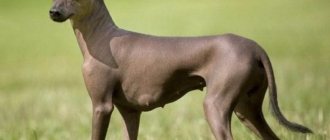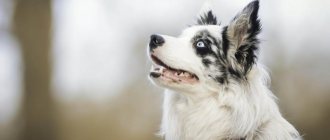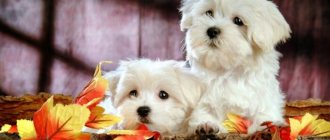Review author: “ZooVita”
The cute collie has long won the hearts of Russians. She aroused particular interest in the 90s, after the release of the film “Lassie Returns”. Everyone who managed to see the movie certainly wanted to have such a pet as a loyal friend and protector. Children especially dreamed about her.
She has many names: some call her Scottish Collie, others Lassie, and others like the name Longhair or English Collie. All of the above statements refer to one breed - the Scottish Shepherd.
However, few people know that there are a lot of collie breeds, and among them there are guard dogs that are far from the usual Scottish dog in appearance. For example, the Border Collie breed.
History of the Scottish Sheepdog breed
Scottish Shepherds began to develop into a separate breed at the end of the 19th century. Until then, they were classified as part of the large family of herding collies, used as cheap labor when it came to protecting sheep flocks. It is believed that Queen Victoria gave the dogs a start in life, who first settled a male collie named Noble in her palace kennel, and then several of his relatives. As a result, by 1860, a stratification had emerged in the clan of herding shepherd dogs, during which a variety of larger individuals with thick reddish hair emerged.
Scottish Shepherds acquired their recognizable aristocratic appearance as a result of interbreeding. For example, the elongated muzzle of the collie was inherited from the Russian greyhound, and the tawny color of the fur coat was inherited from the Irish setter. Work on the formation of the breed’s phenotype lasted for several decades, but since 1885, “specimens” that were similar to modern dogs have already been encountered at European exhibitions. One of these stars of the ring was the male Old Cocky, considered the great-great-grandfather of today's collies.
At the end of the 19th century, the short-haired and long-haired varieties of Scottish Sheepdogs were finally separated. And although until the end of the 20th century their representatives were crossed with each other, now dogs with smooth hair and fluffy individuals belong to different breed types. Moreover, short-haired collies continue to be considered a rarer family than their shaggy cousins.
In Russia, the first owner of the Scottish Shepherd breed was Tsar Nicholas II. According to one version, the puppy was given to the imperial family by the same Queen Victoria, and according to another story, the dogs were purchased by the monarch himself on a trip abroad. After the October Revolution, the trace of the emperor’s wards was lost, but by that time a service dog breeding section had opened in Leningrad, where they were engaged in breeding and improving the working performance of collies.
With the beginning of the Great Patriotic War, four-legged pupils of Leningrad nurseries were called up for service, so that only five purebred individuals survived the blockade of the city on the Neva, from which all lines of Soviet collies subsequently descended. Like most breeds in the USSR, the “Scots” were bred in complete isolation, without a rush of blood from outside, so domestic shepherd dogs differed from their European and American counterparts both in appearance and in terms of temperament. As an example: all Soviet individuals were tall and had a rather explosive character, since in the Soviet Union puppies were initially introduced to official activities. It was possible to obtain relatively good-natured and smaller livestock only in the early 90s, with the advent of the possibility of importing breeding bitches and dogs from other countries.
Scottish Sheepdog breed standard
The collie is a slender aristocrat with a slightly sly expression on his long muzzle and an equally cunning look. Despite the fact that today's individuals no longer herd sheep that have strayed from the herd, a strong build, without a bias towards coarseness and dampness of the bones, remains the defining feature of the breed. As for the dimensions of long-haired shepherd dogs, each standard describes them differently. For example, according to FCI specialists, the height of a model collie male is 56-61 cm, and that of a female collie is 51-56 cm. At the same time, the AKC (American Kennel Club) offers its own standards: 61-66 cm for “boys” and 56-61 cm for "girls".
Abundant straight hair, reminiscent of an elegant coat, complemented by a fluffy collar and fluffy tail, is another spectacular attribute of the long-haired variety of the breed. However, it is important to understand that even a record-breaking voluminous and glamorous “outfit” is not able to cover up the physical shortcomings of the animal. To put it simply: in the show ring, the condition, movement and bone structure of a collie are judged more scrupulously than the coat. This happens because historically the ancestors of Scottish Shepherds were bred as working dogs, which means they were much poorer dressed. At the same time, the luxurious “robes” of today’s representatives of the breed are just the result of breeders’ persistent desire for a standard photogenic exterior of their pets.
Head
The elongated dry head of the Scottish Sheepdog should have a blunt wedge shape, but not copy the head of one of its ancient ancestors - the greyhound. The collie's skull and cheekbones are flat, the stop is poorly defined. The head and muzzle are approximately the same length.
Eyes
The main sign that this is a Scottish Shepherd is the sly look of the slanted almond-shaped eyes, which Western breeders characterize as “sweet.” The most common iris color is dark brown. The exception is individuals with marbled fur, for which a blue eye tone is acceptable, as well as heterochromia.
Jaws and teeth
The teeth are large and complete. The jaws are strong, in a scissor-shaped jaw.
Nose
The back of the nasal part of the muzzle is characterized by a slightly rounded shape. The earlobe has a rich black tone.
Ears
Relatively small, the Scottish Shepherd's ears are set at the top of the head and are laid back. The ear flap assumes a semi-raised, forward position only if the dog is interested or worried about something.
Neck
The Collie's muscular, balanced neck should have a pronounced arch and sufficient length.
Frame
The body of an elongated format is an external feature, especially pronounced in females. The back of the Scottish Shepherd is strong, slightly raised in the lumbar region. The chest is deep, wide behind the shoulder blades, with elegantly rounded ribs.
Limbs
The front legs are dry, with oblique shoulder blades, straight forearms and elbows pointing straight back. The hind limbs have a muscular thigh and sinewy lower limbs. The hocks give the impression of restrained power and are dropped downwards. The dog moves at a light, slow trot, pushing off springily with its hind limbs.
Tail
The collie has a long tail, the lower vertebra of which is at the level of the hock joint. When a dog is relaxed, its tail is held downwards and slightly curled upward at the tip. If the animal is excited, the tail is carried cheerfully, but is not thrown over the back.
Wool
The rich undercoat hugs the collie's body tightly, completely hiding the skin. The outer coat is rough, straight, forming a lush mane and frill on the neck, feathering on all four legs and an exquisite “fan” on the tail. The hair on the ear tips and head is short and smooth.
Color
The standard fixes no more than three basic suits:
- sable - all options from lightened gold to darkened sable, with the exception of light straw and cream;
- tricolor – coal-black with red-brown markings;
- blue merle - silver-blue with black narrow streaks and spots, as well as tan markings on the top of the head and legs (the latter quality is optional).
A preferred addition to the color is also the presence of a white shirtfront, collar, tip of the tail and white spots on the paws.
Defects and disqualifying defects
Representatives of the breed are disqualified for cryptorchidism, anatomical deformities, aggressive lunges or excessive cowardice and malocclusions. Any noticeable deviation from the standard is sufficient to reduce the exhibition rating. For example, dogs with an insufficiently filled muzzle, protruding cheekbones and occipital protuberance, and incomplete dental formula will not be able to qualify for the championship. The same fate awaits Scottish Sheepdogs with a short stocky body, erect ears, soft hair and cow-like legs.
Appearance characteristics
In the photo of a collie dog you can see large ears, expressive eyes, a narrow, elongated muzzle, the bite is almost always correct, the shape of the eyes is almond-shaped, the color is brown, red, even reddish.
The ears are predominantly triangular in shape, stand at 2/3, and the tips hang down.
Based on the type of coat color, the following types are distinguished:
- Sable. The color of the coat is brownish-yellow, the inside of the down is white.
- Mahogany. The coat color is wheat-gold or rich brown.
- Puke merle. The main color is white with admixtures of black and pockmarked shades.
- Tricolor. Coat color is whitish, black and brown.
Character of the Scottish Sheepdog
Collie is a charismatic intellectual who knows how to build warm relationships not only with the owner and his family members, but also with furry “antagonists” in the form of other dogs and domestic cats. One of the most pleasant and rare qualities of the breed is the absence of extremes in character and temperament. We can say that in its soul the animal carefully weighs the validity of each action, fearing to overdo it, therefore the correct Scottish Shepherd is playful and active, but will not create something like a natural disaster in the house; she is eager to contact the owner, but never transforms into a delivery dog, from whose attention you want to hide in another room.
In relations with strangers, furry aristocrats are also extremely diplomatic - despite the natural distrust of a stranger, the long-haired collie will not allow itself to descend to a threatening growl and display of fangs. That is why the breed is reluctant to become a bodyguard, preferring to trust its representatives with search and guard work. Shepherds have a permanent partnership with children, so if your heirs need a patient and inexhaustible nanny, take a closer look at the collie. The only caveat: to achieve maximum effect, you will have to raise the future “babysitter” yourself - dogs that have not had contact with children until adulthood, alas, are not so child-loving.
Almost all dog handlers note the unusual talkativeness of the breed. And it’s not just about the vocal reaction to intrusion or extraneous sounds - a true “Scotsman” is not averse to chatting with the owner for no reason. So don’t be surprised when, in response to a word spoken to your pet, you hear something grumbling, shrill or howling. In relation to other representatives of the fauna, Scottish Shepherds behave in a reserved and peaceful manner, and they carefully protect small livestock and poultry from encroachment. A collie can only present unpleasant surprises by succumbing to collective euphoria. For example, when a pack of other dogs chases a cat or a bird. A four-legged shepherd will most likely join in such a fun activity - whatever one may say, pack instincts still play a significant role in the life of shepherd dogs.
Take into account the fact that there are no dogs that are exact copies of each other, both in appearance and in behavior, so it is pointless to compare the puppy you got and the one that lives in a friend’s house. Often, differences in the character of animals are also due to the geography of breeding. For example, dogs from American lines are more temperamental than their European relatives. By the way, in terms of physical activity, Scottish Shepherds, although lively, are quite manageable, which cannot be said about their cousins - short-haired collies, whose internal battery always works at the limit of its capabilities.
Education and training
Intelligent, efficient and incredibly inquisitive, collies are among the top easiest to train breeds. However, it is possible to achieve positive and quick results only if there is a friendly attitude. Remember, the Scottish Shepherd has a vulnerable psyche and categorically does not accept an authoritarian style of communication. Moreover, the home atmosphere plays a huge role for her. If the family communicates in a raised voice, it is stressful for the pet, which prevents it from delving into the educational process and turns the puppy into a stupid, nervous creature.
Don't be afraid that your shaggy friend will misinterpret your loyalty during the training and begin to pretend to be the “big boss”. The breed is not prone to dominance in principle and prefers kind mentoring from the owner. Otherwise, Scottish Shepherds are raised according to the same pattern as most breeds. First - socialization and establishing contacts with family members, then - getting used to the daily routine, then - getting to know the street, new smells and sounds.
At all of these stages, you can and should introduce the puppy to basic commands. At 2 months, the four-legged prankster is taught to respond to the call “Come to me!” and understand the order “Place!” At 3 months, the pet is introduced to the leash and the commands “Walk!”, “Sit!” 4 months is the optimal age to learn the orders “Near!”, “Ugh!” and “Lie down!” Well, a six-month-old teenager is able to master more complex actions, for example, fetching on command and the requirement to “Stop!” By the way, about fetching: collies are one of the few breeds with a reduced tendency to chew objects, so any toys these shepherds have last longer.
It is better to work with the “Scot” on the street, and first you should take the puppy for a walk, and then get down to business. During the first lessons, your pet will be distracted by external stimuli, and this is normal. Gradually, the animal will learn to control its own attention and concentrate on human demands. The main thing is not to overdo it with repetitions of commands and the duration of classes. The time interval during which a Scottish Longhaired Sheepdog is able to maintain attention on one action is 5-10 minutes.
As for training programs, the breed copes perfectly with UGS and OKD. The international standard for obedience (obedience) also passes the majority of individuals. Theoretically, nothing prevents the owner from walking with a collie and a ZKS, but this is done more often “for show” - the character of Scottish Shepherds lacks healthy aggression and suspicion, so necessary for a bodyguard dog.
Maintenance and care
Like all historically working breeds, Scottish Shepherds are not afraid of temperature changes and are able to live in a kennel or enclosure. However, in practice, it is not worth relocating a pet to a yard on a permanent basis for two reasons. Firstly, because of the contact nature of collies, which require constant interaction with their owner. And secondly, because of the overly luxurious wool, which perfectly collects small debris. Residents of country cottages will have to think about how to provide their animals with free access from the street to the house and back. Well, apartment owners should prepare for regular promenades in the company of a pet.
Hygiene
The main problem of collies is, first of all, wool. Lots of wool. Dogs shed seasonally, in autumn and spring, but this happens to individuals living in the fresh air. Apartment shepherds shed hair less spontaneously, but throughout the year. Puppies acquire fluffy fur coats only at the end of the first year of life, and in the process of changing from children's “clothes” to adult ones, they will have to be helped with brushing, and occasionally with bathing - this way the puppy’s hair comes off faster. Molting of females is a separate issue. Bitches renew their coat after each birth, and often the new regrown hair is not very impressive.
Brush your non-shedding collie once a week, making sure to moisten the coat with detangling spray. The tail is combed carefully and strictly according to the hair growth - this part of the body has poor blood supply, so with dead hairs there is a risk of pulling out healthy ones. Don’t be alarmed if your faded pet looks like a slightly shabby creature – this is normal. Gradually, the renewed undercoat and guard will gain the required strength and thickness. The only caveat is that you won’t show up at an exhibition with such an unevenly “dressed” dog.
Useful tools for working on the coat of a Scottish Sheepdog are combs with rare and fine metal teeth, a brush, scissors for trimming the hair behind the ears and on the paws. It is recommended to wash the animal with shampoo for wire-haired dogs, no more than 2-3 times a year. The collie is also supposed to have a pedicure every month with a nail clipper for large and medium-sized breeds, and once a week the dog’s ear funnel is cleaned of excess wax secretions (a cotton cloth and warm water is enough).
Strict supervision is required over the eyes of your four-legged friend. And if you can remove dust bunnies from the mucous membrane at home using a chamomile decoction and a cloth napkin, then in case of redness and visible inflammation, you will have to resort to the services of a veterinarian. Post-walk hygiene is also part of the mandatory care program. After the promenade, you need to wash the dog’s paws, periodically nourishing the skin of the pads with unrefined vegetable oil or rich cream. It is better to cut the hair between the toes - this way the paws will get less dirty, and in winter a crust of ice and reagents will not grow on them.
Walking and physical activity
It’s great if you have enough time to devote at least 4 hours a day to walking and jogging in the company of a collie. However, compromises are also possible. For example, in the morning and afternoon it is permissible to take a shepherd dog out for a short “toilet” promenade, but in the evening he will have to be compensated in the form of a full two-hour walk. Individuals moving freely around the yard and garden plot are also allowed to slightly reduce the timing of daily excursions. By the way, you can let your collie wander around the fenced yard without unnecessary worries - the breed is not prone to escape and does not make digs to escape into the wild.
If you live in a city where there are areas for training dogs in sports herding, it makes sense to sign up your furry ward for classes. Frisbee disc exercises are considered a good way to warm up. And in winter you can practice skijoring - the Alaskan Malamute and Labrador Collie will not outshine in this discipline, but will receive physical and emotional release, and will also provide the owner with fun. Pitch and go is considered a positive and relatively easy sport - the good old fetch of objects on command. In the summer, it is recommended to carry the fun to the banks of reservoirs, that is, throw an object into the water, from where the collie will retrieve it. Scottish Shepherds like such attractions - the breed is an excellent swimmer and is not averse to cooling off on a hot day.
After water treatments, the dog’s fur should be doused with slightly warmed running water and blotted with a terry towel, since raw hair is a breeding ground for bacteria, which is the cause of the unpleasant odor emanating from the animal. During the slushy off-season, it is more convenient to walk collies in protective overalls - although the breed’s wool has dust-repellent properties, this does not protect the bellies of its representatives from liquid mud.
Feeding
The easiest way to meet the nutritional needs of a Scottish Sheepdog is to feed it a dry diet containing natural meat. As a rule, these are super-premium and holistic varieties, selected individually, depending on the activity, health and age of the individual. A natural menu is no less useful, but its preparation will require effort from the owner in selecting products and processing them.
Scottish Shepherds eat the same things as other dogs, that is, lean raw meat, boiled and raw sea fish fillets, vegetables (pumpkin, zucchini, carrots), low-fat fermented milk products. It is useful to give calcined cottage cheese to puppies whose bones are developing. Porridge with buckwheat, rice and rolled oatmeal is cooked in milk for babies, and in broth for adult animals. Sometimes puppies and teenagers are allowed to indulge in a flat beef bone, but keep in mind that the young dog should chew it lightly and not eat it whole. For excessively fat collies, it is advisable to arrange fasting days on which only water is offered, however, it is better to coordinate pre-therapeutic fasting with a specialist.
Some owners give their four-legged charges vitamins that improve growth and coat structure. But you should approach the selection of dietary supplements with caution, since such complexes damage the liver. It is better to replace ready-made preparations with fish oil and unrefined vegetable oil, although they should be added in very moderate quantities. Seaweed is also a useful dietary supplement, although the iodine it contains can color an animal’s fur. Accordingly, if you are raising a show dog that is about to go to a show, it is better to keep the intake of kelp to a minimum.
Health and Diseases of Scottish Sheepdogs
On average, collies live 12-14 years, although exceptions to the rule, those who meet their 16th birthday in good health, are not so rare. Genetic diseases plague Scottish Sheepdogs to a lesser extent than most popular breeds, due to the working status in which representatives of this canine clan have been for a long time.
The specific hereditary diseases to which “Scots” are susceptible most often include the ocular anomaly CEA, which has several degrees of severity and is diagnosed in 5-7-week-old puppies. In adults, CEA can only be detected using DNA tests. Before buying a puppy, find out from the seller whether the producers are carriers of a defective gene that is passed on to the offspring, and ask to see the results of the examination.
Animals with the blue merle color sometimes exhibit congenital deafness. In addition, some representatives of the breed suffer from degenerative myelopathy, ectopic ureters, hip dysplasia and dermatitis. Anomalies in the development of the eyelid also still occur, so from time to time offspring are born with everted or inverted eyelids, as well as distichiasis.
Features of the diet
This breed of dog needs special attention to its diet. You cannot give food from a common table, and it is also unacceptable to overfeed the animal.
The most popular dog names in alphabetical order with recommendationsShar Pei - history of the breed, character traits, care and possible problems + 87 photos
American Bulldog - history of the breed, appearance, specifics and characteristics, care (100 photos + video)
If there are no allergic reactions, you can keep your pet on natural products.
How to choose a puppy
- Give preference to single-breed nurseries where they breed exclusively long-haired collies, rather than raising five or more breeds.
- Become a regular on breed forums and carefully read real reviews about breeders and nurseries - in such places you can find a lot of useful information and check the seller’s honesty.
- Evaluate the appearance of the litter's mother. The dog should not look emaciated and have an exhausted appearance, as well as its offspring.
- Take the puppy only when you are sure that he can feed himself. To do this, stay in the nursery until the next feeding and watch how the babies eat.
- If the total area of white marks on the body of a collie puppy is 50% or more, get ready to consider him as a pet. The path to exhibitions for such a shepherd will be closed.
- For those who are taking their first steps in dog training, it is better to choose a “girl”. Scottish Shepherd females are less obstinate and easier to train.
- Collie is a talkative breed, but if the puppy barks at you non-stop when you first meet him, choose another baby. In the future, such talkativeness will cause a lot of problems with neighbors.
- Before visiting the kennel, print out the Fisher and Campbell tests, which help determine the personality traits and abilities of the puppy, and coordinate their administration with the breeder.
Color
- Sable with white;
- Tricolor;
- Blue Merle;
- Mahogany.
After looking at photos of collies, you will fall in love with this breed. No matter the coat or color, the collie looks very attractive and beautiful.
Scottish Sheepdog price
Today you can purchase a long-haired collie puppy, as well as sign up for the next litter, at the nurseries “Daenerys”, “Nixend”, “Eli Evenstar” and others. And get ready to travel: some of the breeders live in regions in the south and north of the country. The approximate price of a Scottish Shepherd puppy with an RKF metric and a decent pedigree ranges from 25,000 to 40,000 rubles. Offspring with promising appearance from producers with international diplomas will cost 10,000 - 20,000 rubles more.
Collie varieties by size
All breeds in this group vary in size:
- large, height at withers up to 61 cm, weight up to 30 kg;
- medium, height at withers up to 54 cm, weight up to 22 kg;
- small, up to 37 cm high at the withers, weighing up to 10 kg.
The smallest representative of this group of herding dogs is the Sheltie (Shetland Sheepdog), its weight does not exceed 10 kg.
Breed standards on the RKF website
Collie on Wikipedia
Dog shows on the zoo portal website











